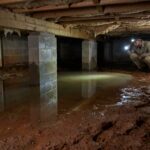Essential Guide to Effective Basement Waterproofing: Protect Your Home from Water Damage
When it comes to maintaining a home, few things are as crucial as ensuring that it remains dry and free from water damage. The basement, often relegated to a dark and dusty corner of the house, is particularly vulnerable. After all, it’s a space where water seems to have an uncanny knack for showing up uninvited. Whether it’s from heavy rainfall, melting snow, or rising groundwater, the last thing you want is for your basement to turn into a swimming pool. So, let’s dive into an essential guide to effective basement waterproofing that will help you protect your home and maintain its value.
Understanding the Importance of Basement Waterproofing
Before we roll up our sleeves and get into the nitty-gritty of waterproofing, it’s important to understand why this process is so critical. Water damage can lead to a host of problems: mold growth, structural damage, pest infestations, and a decline in indoor air quality. Furthermore, if you ever decide to sell your home, potential buyers will be wary of a damp basement. Nobody wants a home that feels more like a cave than a cozy dwelling.
Signs You Need Waterproofing
So how do you know if your basement needs some serious waterproofing action? Here are some common signs:
1. **Dampness**: If your basement feels humid or smells musty, it’s a red flag.
2. **Water Stains**: Look for those unsightly brown stains on the walls – they’re not just decorative.
3. **Mold**: If you’re finding little black or green spots on surfaces, it’s time to act.
4. **Puddles**: If it rains and your basement resembles a water park, you’ve got an issue.
5. **Cracks in Walls**: Small fissures can become major problems over time.
If any of these signs sound familiar, it might be time to take a closer look at your basement (and perhaps grab a flashlight).
Types of Basement Waterproofing Methods
Now that we’ve established the importance of waterproofing and how to identify potential problems, let’s discuss the various methods available. There’s no one-size-fits-all solution, but here are some popular options:
**1. Interior Waterproofing**
This method involves making your basement less permeable to water from the inside. Here’s how it works:
– **Sealing Cracks and Joints**: Use a hydraulic cement or epoxy compound to seal any visible cracks. This is akin to putting a Band-Aid on a wound, but sometimes a little patching is all you need to keep the moisture at bay.
– **Sealants**: There are specialized sealants designed to waterproof walls and floors from the inside. Just remember this isn’t like painting a room; you need to follow instructions closely.
**2. Exterior Waterproofing**
For more severe cases, you might need to tackle the problem from the outside. This generally involves more construction work but is typically more effective in the long run.
– **Excavation**: This might sound daunting, but digging around your home’s foundation is important. Once you expose the foundation, you can apply a waterproof coating.
– **French Drains**: These clever systems utilize perforated pipe and gravel to redirect water away from your home. It’s like giving your basement a personal bodyguard against groundwater.
**3. Sump Pumps**
Sump pumps are fantastic allies in the fight against water invasion. Placing a sump pump in your basement will help remove excess water. When the water level rises, the pump kicks into gear and pumps the water out. It’s like having a superhero on standby!
– **Battery Backup**: Don’t forget to consider a battery backup system, especially if you live in an area prone to power outages during storms. Nothing worse than your hero taking a nap when you need them the most.
**4. Dehumidifiers**
While not necessarily a waterproofing method, dehumidifiers can help maintain optimal humidity levels in your basement. They work by removing moisture from the air, which can prevent mold growth and keep the space feeling fresher. Think of it as your basement’s air conditioner – no summer BBQs allowed in a damp environment!
Planning Your Waterproofing Strategy
So, what should you consider before embarking on your waterproofing journey? Here are a few key points:
– **Assess Your Situation**: Before you start any work, take a good look at your basement. Identify problem areas and prioritize them. This will save you time (and possibly money) in the long run.
– **Budget**: Waterproofing can range from a DIY project to hiring a professional crew. Create a budget that reflects your situation, but don’t skimp on quality. This isn’t a place to cut corners; you don’t want to be the person with a leaky basement a year later.
– **Consult with Professionals**: If you’re unsure about tackling an issue, don’t hesitate to call in experts. They can provide insight and solutions tailored specifically to your home’s needs.
DIY vs. Professional Help
Feeling adventurous? A DIY waterproofing project can save you money, but you need to know what you’re doing. If your basement issues are relatively minor, such as sealing small cracks, this could be a great weekend warrior project. However, if you’re dealing with significant water intrusion, structural issues, or extensive mold, you might want to leave it to the pros. Remember, ignorance is not bliss when it comes to home repairs.
Maintenance Tips to Keep Your Basement Dry
Just because you’ve waterproofed your basement once doesn’t mean you can forget about it. Regular maintenance is key to keeping the water away. Here are some helpful tips:
– **Gutter Maintenance**: Ensure your gutters and downspouts are clear and functioning properly. Clogged gutters can cause overflow, leading to water pooling around your foundation. Regularly check for leaves, twigs, and all that fun stuff.
– **Check Grading**: Make sure the ground around your home slopes away from the foundation. This helps divert water away instead of pooling right next to your home.
– **Inspect Seals and Caulking**: Regularly check any seals or caulking you applied and redo them as needed. No permanent solutions here; even the best seals wear out over time.
– **Monitor Humidity**: Keep an eye on humidity levels in your basement. If it starts creeping up, consider running a dehumidifier to bring it back down.
Final Thoughts
Waterproofing your basement may feel like a daunting task, but it’s an essential investment in protecting your home from water damage. By understanding the various methods available and taking proactive measures, you can keep your basement dry, mold-free, and functional. Remember, a little prevention can go a long way. And hey, with a waterproofed basement, you’ll have a good excuse to throw the occasional “basement party” without worrying about unexpected water features!
So, roll up those sleeves and get to work. Your home (and your future self) will thank you!


